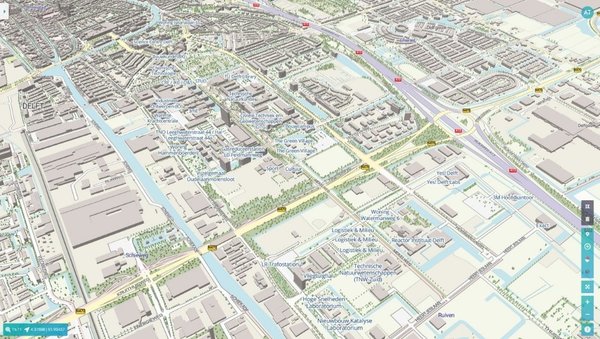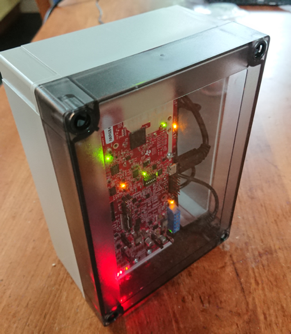How the Internet of Things is changing the TU Delft Campus into a living lab
In times of this pandemic, the TU Delft Campus has changed into a living lab for monitoring traffic flows on and around the campus. The plan for this type of monitoring already existed, but due to COVID-19 the implementation of the project has been intensified.The development of the Outdoor Mobility Digital twin is led by Dr. Sascha Hoogendoorn of the Mobility Innovation Centre Delft (MICD) and Prof. Serge Hoogendoorn, of the Transport&Planning Department at the TU Delft Faculty of Civil Engineering and Geosciences. With the help of 30 (camera) sensors around the campus and with the use of openly available public transport and car traffic data, the flows of people and traffic on and around the campus can now be visualised and monitored on a dashboard in (near) real-time. This data helps to predict the location, density and direction of flows of people on campus and can show the effect of implemented safety measures and policies.
The dashboard is currently put into use as part of the COVID-19 Digital Campus project, whose focus is on supporting the so-called “1,5 m society”. It is used to monitor if people are maintaining enough distance and to identify crowded places where there is an increased contagion risk. The ultimate goal is to reliably predict the movements on campus and the locations where we expect problems to occur in the short term (15 minutes) but also in the longer term (days or weeks). The wish is to, together with the local government, expand the dashboard to the whole of Delft. This could be used to advise people to take less busy routes, avoid crowded places, travel at a different time or take a different mode of transportation.
Do IoT Fieldlab is contributing to the dashboard with the development of mmWave sensors, which will be a great addition to the existing sensor network of the MICD. Marco Zuniga, Przemysław Pawełczak, and Fernando Kuipers, of TU Delft Faculty of Electrical Engineering, Mathematics & Computer Science, are working on the development and deployment of mmWave sensors that can be used to count people and monitor the flows of individuals without identifying them. These sensors operate like the radars used to track airplanes: a wireless signal is transmitted, and its reflection is captured and represented as dots on a screen. The advantage of these sensors is that their very high frequency (with wavelengths in the mm range) provides sufficient information to tell the difference between a person and animals, bike, cars, etc., but it is not fine-grained enough to capture personally identifiable information. The ambition for the mmWave sensors is that they will be cheaper and more energy efficient than the sensors with similar functionalities that are currently
being used. This research is conducted in collaboration with the AMS research Institute in Amsterdam and the Dutch start-up BeepBeep. When the development of the sensors is completed they will become part of the sensor network of the mobility dashboard.
In light of the deployment of 5G at the TU Delft Campus as enabling technology for IoT, it will be possible to expand this sensor network, collecting and processing vast amounts of data and transmitting it in real-time to the central monitoring location and outdoor mobility digital twin. By combining and enriching all available data about people’s locations and movement and the availability of mobility services on and around the campus, we can organize the traffic flows much better and make optimal use of existing and new services provided. Moreover, integration with 5G technology will enable the further development and introduction of innovative mobility services that specifically require highly reliable, low-latency communication, such as self-driving vehicles and traffic safety control.
Although the short term focus of the Outdoor Mobility Digital twin lies on informing campus management about crowd development, critical locations, and whether social distancing can be adhered to, many more future applications for it are foreseen where IoT can play a role. For instance, creating a better connection between the Delft Campus train station and Campus Zuid. Or new algorithms for controlling traffic lights, for example through direct communication with pedestrians and cyclists, offering new transportation services to move to, from and on campus, parking reservation systems, etc. In short: the possibilities for the development of IoT and new sustainable mobility solutions are endless as the communication infrastructure, sensor network and dashboard are intended to grow into a fully-fledged fieldlab for innovation in mobility.
Do IoT Fieldlab offers an open platform focused on the development and use of Internet of Things and 5G. Researchers, companies, government and students can develop and test IoT applications based on the latest wireless communication technology in collaboration with the fieldlab. Together we innovate in the Internet of Things for a more sustainable, safer and healthier society. Follow us online on LinkedIn or Twitter!


